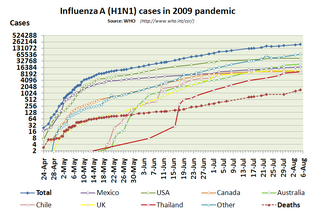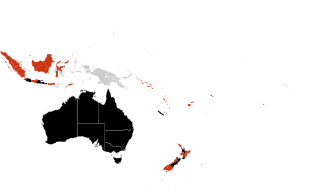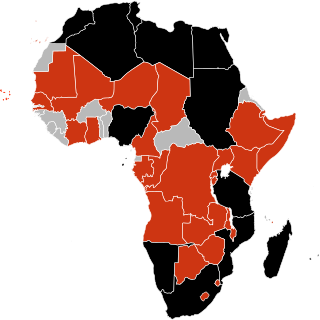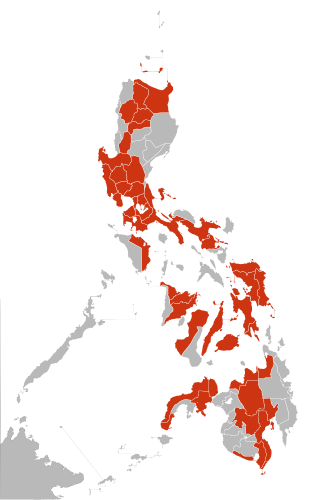
Influenza A virus subtype H1N1 (A/H1N1) is a subtype of influenza A virus (IAV). Some human-adapted strains of H1N1 are endemic in humans and are one cause of seasonal influenza (flu). Other strains of H1N1 are endemic in pigs and in birds. Subtypes of IAV are defined by the combination of the antigenic H and N proteins in the viral envelope; for example, "H1N1" designates an IAV subtype that has a type-1 hemagglutinin (H) protein and a type-1 neuraminidase (N) protein.

The 2009 swine flu pandemic in Canada was part of an epidemic in 2009 of a new strain of influenza A virus subtype H1N1 causing what has been commonly called swine flu. In Canada, roughly 10% of the populace has been infected with the virus, with 428 confirmed deaths ; non-fatal individual cases are for the most part no longer being recorded. About 40% of Canadians have been immunized against H1N1 since a national vaccination campaign began in October 2009, with Canada among the countries in the world leading in the percentage of the population that has been vaccinated. The widespread effect of H1N1 in Canada raised concerns during the months leading to the XXI Olympic Winter Games, which took place in Vancouver in February 2010.

This article covers the chronology of the 2009 novel influenza A (H1N1) pandemic. Flag icons denote the first announcements of confirmed cases by the respective nation-states, their first deaths, and relevant sessions and announcements of the World Health Organization (WHO), the European Union , and the U.S. Centers for Disease Control (CDC).

In March and April 2009, an outbreak of a new strain of influenza commonly referred to as swine flu infected many people in Mexico and parts of the United States causing severe illness in the former. The new strain was identified as a combination of several different strains of Influenzavirus A, subtype H1N1, including separate strains of this subtype circulating in humans and in pigs. Spain was the first country in continental Europe to report cases of swine flu, in late April 2009.

This article deals with the status and efforts regarding the 2009 swine flu pandemic by country and continent/region.

In March and April 2009, an outbreak of a new strain of flu, popularly known as swine flu, was discovered to have infected several people in Mexico and the states of California and Texas in the United States. On April 28 Costa Rica became the first Central American country to report the outbreak of the virus, with a confirmed infection. As of November 4 the Costa Rican Ministry of Health had 1,596 confirmed cases, 1,275 pending cases, 8,000 already discarded, and 38 deaths.

The pandemic H1N1/09 virus is a swine origin influenza A virus subtype H1N1 strain that was responsible for the 2009 swine flu pandemic. This strain is often called swine flu by the public media due to the prevailing belief that it originated in pigs. The virus is believed to have originated around September 2008 in central Mexico.

The 2009 swine flu pandemic spread to Brazil on April 25, 2009, with two people, spreading to 34 over the first two weeks. CDC calculate that Africa and Southeast Asia, which have 38% of the world's population, accounted for a disproportionate 51% of the deaths.

The influenza A virus subtype H1N1 arrived in Argentina in late April 2009, through air traffic contact with endemic areas, especially Mexico and the United States. The World Health Organization (WHO) and the Argentine health authorities expressed their concern from the beginning of the outbreak, that the imminent arrival of the southern winter could cause "more serious" effects in the southern hemisphere than those caused in Mexico, and could lead to a rebound of the epidemic around the world. The flu or influenza is mainly a seasonal disease that becomes most prevalent in winter.
The 2009 flu pandemic in South America was part of a global epidemic in 2009 of a new strain of influenza A virus subtype H1N1, causing what has been commonly called swine flu. As of 9 June 2009, the virus had affected at least 2,000 people in South America, with at least 4 confirmed deaths. On 3 May 2009, the first case of the flu in South America was confirmed in a Colombian man who recently travelled from Mexico – since then, it has spread throughout the continent. By far, the most affected country has been Chile, with more than 12,000 confirmed cases, 104 deaths, and the highest per capita incidence in the world.

The 2009 flu pandemic in Asia, part of an epidemic in 2009 of a new strain of influenza A virus subtype H1N1 causing what has been commonly called swine flu, afflicted at least 394,133 people in Asia with 2,137 confirmed deaths: there were 1,035 deaths confirmed in India, 737 deaths in China, 415 deaths in Turkey, 192 deaths in Thailand, and 170 deaths in South Korea. Among the Asian countries, South Korea had the most confirmed cases, followed by China, Hong Kong, and Thailand.

The 2009 swine flu pandemic in North America, part of a pandemic in 2009 of a new strain of influenza A virus subtype H1N1 causing what has been commonly called swine flu, began in the United States or Mexico.

The 2009 flu pandemic in Oceania, part of an epidemic in 2009 of a new strain of influenza A virus subtype H1N1 causing what has been commonly called swine flu, has afflicted at over 22,000 people in Oceania, with 56 confirmed deaths. Almost all of the cases in Oceania have been in Australia, where the majority of cases have resulted from internal community spread of the virus. In addition, the government of New Zealand, where most of the remainder of cases in Oceania have occurred, is on high alert for any people travelling into the country with flu-like symptoms.

The 2009 flu pandemic in Europe was part of a pandemic involving a new strain of influenza, subtype H1N1. H1N1 is commonly called swine flu. The pandemic infected at least 125,550 people in Europe. There were 458 confirmed deaths in Turkey, 438 confirmed deaths in Russia, and 457 confirmed deaths in the United Kingdom.

The 2009 flu pandemic hit Africa two months later than other continents with the first case reported in Egypt on June 2, 2009. As of December 1, 30 countries in Africa had reported cases and 7 countries in Africa had reported a total of 108 deaths. It was the least affected continent.

The Influenza A (H1N1), also known as the swine flu, was detected in Venezuela on 28 May. The first infected person was a 22-year-old man in San Antonio de Los Altos, Miranda State. He was participating on a meeting in Panamá, and returned to Venezuela carrying the virus

The 2009 swine flu outbreakinMalaysia was part of a larger flu pandemic involving a new type of influenza A virus subtype H1N1 (A/H1N1). As of 11 August 2009, the country had over 2,253 cases, beginning with imported cases from affected countries, including the United States and Australia, from 15 May 2009 onwards, and the first identified local transmission on 17 June 2009. On 12 August 2009, the Malaysian Health Ministry announced that it had discontinued officially updating the total number of H1N1 cases within Malaysia in line with guidelines issued by the World Health Organization. As of 21 August 2009, the unofficial number of cases reported in the media was 5,876. The first death related to the (A/H1N1) virus was reported on 23 July 2009, and there have been 78 deaths reported so far. On 6 July 2009, Malaysia announced a shift from containment to mitigation to tackle the spread of the virus. The federal government declared a national health emergency in Malaysia due to the (A/H1N1) outbreak and was considering imposing a health curfew similar to the week-long shutdown of non-essential services and industries in Mexico.

The 2009 swine flu pandemic in New Zealand was caused by a novel strain of the A/H1N1 influenza virus. A total of 3,175 cases and 69 deaths were recorded, although a seroprevalence study estimated that around 800,000 individuals may have been infected during the initial wave of the pandemic.

The 2009 flu pandemic in the Philippines began on May 21, 2009, when a young Filipina girl first contracted the A(H1N1) virus while in the United States. In the following days, several local cases were reported to be caused by contact with two infected Taiwanese women who attended a wedding ceremony in Zambales.

The 2009 flu pandemic, an influenza outbreak commonly known as "swine flu", affected Portugal from May 2009 to early 2010. The outbreak caused 122 deaths in the country.


















